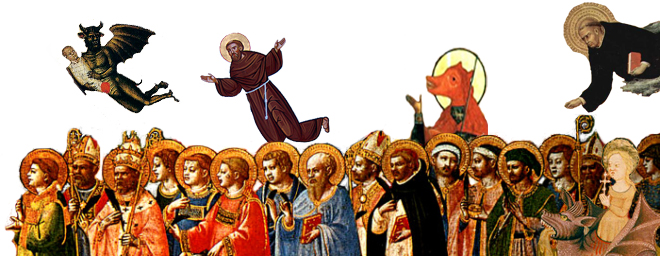
A few months ago, Pope Francis elevated former popes John XXIII and John Paul II to sainthood. What does that mean? While the word “saint” carries a baggage of different meanings today depending on the denomination it’s used in, generally speaking a saint is a holy individual (i.e. believer in Christ) who has earned the rewards of heaven after death. In the more Catholic sense, a saint is someone with whom Christ dwells, giving them an exceptional level of holiness as displayed through heroic and philanthropic deeds one earth. After their death, the Catholic Church comes to recognize and canonize some of these individuals who are now in heaven. [1]
While the Catholic Church recognizes a great number of individuals as saints, they by no means claim to have a complete or even a nearly complete list. How many have they canonized so far? The answer isn’t an easy one to find. Using official church sources it tallies close to 1,000. Elsewhere, it appears to exceed 10,000. That’s a lotta saints marching in. Note that these are numbers within the Roman Catholic religion. The numbers may be even higher among the Eastern Orthodox and Oriental Orthodox congregations, since their “canonization” process isn’t nearly as fixed. It shouldn’t come as a surprise that with so many saints to choose from there are a handful of individuals whose legends are worth reading about purely for entertainment in addition to historical interest. Never did I imagine how surprisingly bizarre they would turn out to be, aided especially by artwork which has strongly preserved their tradition. So without further ado, here’s my top eleven.
If you’d simply like to view their depictions in art, check out my gallery of each saint here.
- St. Catherine of Siena (1347 – 1380): The woman Christ married with his foreskin
- St. Bernard of Clairvaux (1090 – 1153): Breastfeed by the Virgin Mary
- St. Christopher (? — c. 251): A giant Cynocephalus (i.e. dog-headed man)
- St. Moses the Black (330–405): Former bandit leader and all-around badass
- St. Stephen (? — 34): Switched at birth for a changeling by Satan
- St. Margaret of Antioch (? — 304): Escaped the belly of a dragon
- St. Joseph of Cupertino (1603 – 1663): The Flying Friar
- Blessed Agostino Novello (1240 – 1309): Your friendly neighborhood monk
- St. Roch (c. 1328 – c. 1376): Saved from the plague by Lassie
- St. Gall (550 – 646): Acquired a pet bear
- St. Veronica (1st century AD): Obtained Jesus’ face on a cloth (Veil of Veronica)
Bonus: Startling iconography of martyred saints (graphic)
- St. Denis of Paris (3rd century AD — c. 250): Carried his own decapitated head
- St. John the Apostle (c. 6 — c. 100): Boiled alive in a vat of oil
- Saint Erasmus of Formia (3rd century AD — c. 303): Disemboweled
- St. Hippolytus of Rome (170 — 235): Pulled apart by horses
- St. Ignatius of Antioch (c. 35 — c. 107): Eaten by Lions
- St. Lucy (c. 283 – c. 304): Had her eyes removed
- St. Agatha (c. 231 — c. 251): Had her breasts removed
- St. Apollonia (? — 249 AD): Had her teeth removed
- St. Bartholomew the Apostle (1st century AD — 1st century AD): Skinned alive
- St. Agnes of Rome (c. 291 — 304): Sent to a brothel then condemned to be burned
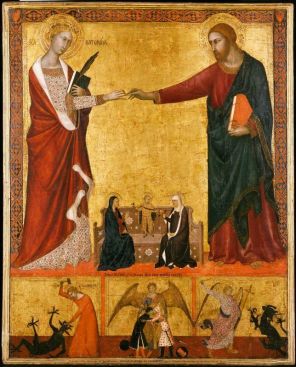 St. Catherine of Siena (1347 – 1380): the woman Christ married with his foreskin
St. Catherine of Siena (1347 – 1380): the woman Christ married with his foreskin
First on our list is the saint which sparked my interest in this long investigation. Quick personal back story: for the past year I’ve been working part time as a caregiver, part of which entails escorting a whimsical old lady to church for Sunday mass. The name of that church is St. Catherine of Siena, and above the pulpit is a mosaic window of the lady herself. One day I decided to google her and discovered that around the age of twenty-one Catherine experienced what she described in her letters as a “Mystical Marriage” with Jesus, entailing “a fusion with Christ’s physicality.”[2] But instead of going to Jared for your usual wedding ring, Jesus placed on her his foreskin (which is also considered a holy relic in the church). She was then told by Jesus to leave her secluded church life and reenter the public sphere to help the ill and the poor throughout the land, a journey which also lead her to become involved in political and religious affairs. Her death at the young age of thirty-three was likely due to her practice of extreme fasting, which in the final year of her life became so aggressive that she was unable to consume water. 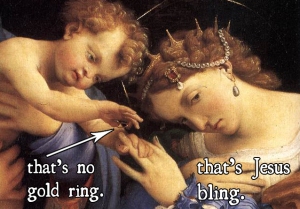
So what exactly is behind this “Mystical Marriage”? Historians are convinced that Catherine of Siena’s vision was heavily influenced by the legend of a previous saint named Catherine – St. Catherine of Alexandria (c. 282–c. 305) – who as a teenager also had a vision of a mystical marriage to Christ. While St. Catherine of Alexandria probably never existed, she became quite an icon in the late Middle Ages during which her legend first appears to have been written down, namely ten years before Catherine of Siena was born. And so, having certainly been familiar with and inspired by the legend, our St. Catherine of Siena was driven to believe that she had had the same holy experience. Both saints can be seen in artwork throughout the centuries receiving Christ’s engagement – sometimes (but rarely) receiving it together. It would seem that the two are often easily conflated in the Catholic tradition; for example, in the mosaic window of the church that I mentioned earlier, Catherine of Siena’s right hand is placed on a breaking wheel standing at her side. What’s interesting is that the breaking wheel is a symbol of St. Catherine of Alexandria, not Siena, as she was supposedly tortured on one during her martyrdom while our Catherine wasn’t martyred. So either the artist wanted to recognize both of them by using iconography of each, or (less likely) he got his Catherine’s mix up, which I think would be quite amusing.
Click here to view more artwork of St. Catherine of Siena
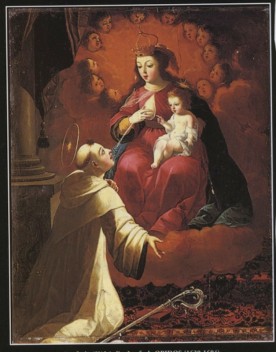 St. Bernard of Clairvaux (1090 – 1153): Breastfeed by the Virgin Mary
St. Bernard of Clairvaux (1090 – 1153): Breastfeed by the Virgin Mary
Yes, you read that correctly. One day, according to legend, Saint Bernard was praying before a statue of the Virgin Mary and said, “Show that you are a mother…” (Monstra te esse matrem). The statue suddenly came alive and squirted milk on Bernard’s lips (with miraculous aim I might add). As a result, Bernard became a spiritual son of Mary sharing a kinship with Christ who was also nourished by Mary’s milk. A second legend tells of how Bernard fell asleep between prayer, after which the Virgin Mary appeared and nourished him with the wisdom of God by putting her breast into his mouth. [3] As bizarre as such imagery may seem today, it wasn’t so bizarre for Christians centuries ago. Medieval scholar Caroline Bynum explains:
People in the high Middle Ages argued that the ideal child-rearing pattern was for the mother to nurse her own child; in medieval medical theory breast milk is processed blood. According to medieval understanding of physiology, the loving mother, like the pelican who is also a symbol for Christ, feeds her child with her own blood . . . In medieval legends like the lactation of St. Bernard and in the medieval devotions like the sacred heart, milk and blood are often interchangeable, as are Christ’s breasts and the wound in his side. What writers in the high Middle Ages wished to say about Christ the savior who feeds the individual soul with his own blood was precisely and concisely said in the image of the nursing mother whose milk is her blood, offered to the child. [4]
And so, during the Middle Ages and on through the Baroque period much theological and pictorial attention was made on the subjects of Christ’s blood and Mary’s milk. By the Blood of Christ one gained redemption while Mary’s milk became a symbol of nourishment and hope on that road to salvation.
Click here to view more artwork of St. Bernard
 St. Christopher (? — c. 251): A giant Cynocephalus (i.e. dog-headed man)
St. Christopher (? — c. 251): A giant Cynocephalus (i.e. dog-headed man)
The basic story of St. Christopher is that he was a 7.5 ft Canaanite who chose to serve Christ by placing people on his shoulders to help them cross a river. One day a little boy asked for his services, a task that ended up being unexpectedly difficult with the child weighing a lot heavier than he appeared. When they reached the other side the boy revealed himself as Jesus, saying, “You had on your shoulders not only the whole world but Him who made it. I am Christ your king, whom you are serving by this work.” The Christ child then vanished.
So why the dog-faced depiction in Eastern Orthodox artwork? Apparently the Byzantines mistranslated the Latin “Cananeus” (Canaan) to read “canineus” (canine) – thus believing that instead of coming from the land of Canaan, St. Christopher was partly canine. This didn’t seem too far-fetched at the time due to popular folktales of dog-faced people known as 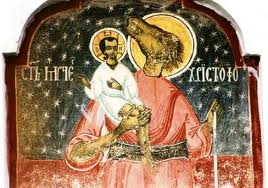 a cyncophalus living in a foreign land. German bishop and poet Walter of Speyer helped spread this unique icon of St. Christopher by writing that he was a giant of this cynocephalic race living in the land of the Chananeans (the “canines” of Canaan in the New Testament) who barked violently and ate human flesh. Then, after meeting the Christ child, Christopher repented for his beastly behavior and received baptism, after which he was miraculously granted human appearance. His lived the rest of his live devoting himself to God as one of his saintly soldiers. Interesting enough, there is also artwork depicting the legend of Jesus making a mission to the “canines” of Canaan.
a cyncophalus living in a foreign land. German bishop and poet Walter of Speyer helped spread this unique icon of St. Christopher by writing that he was a giant of this cynocephalic race living in the land of the Chananeans (the “canines” of Canaan in the New Testament) who barked violently and ate human flesh. Then, after meeting the Christ child, Christopher repented for his beastly behavior and received baptism, after which he was miraculously granted human appearance. His lived the rest of his live devoting himself to God as one of his saintly soldiers. Interesting enough, there is also artwork depicting the legend of Jesus making a mission to the “canines” of Canaan.
Click here to view more artwork of St. Christopher
 St. Moses the Black (330–405): Former bandit leader and all-around badass
St. Moses the Black (330–405): Former bandit leader and all-around badass
At first glance I thought I had stumbled upon a creation by a modern comic book writer. The legend goes that after being released as a slave to an Egyptian politician due to theft and suspected murder, Moses turned to a life of crime, roaming the countryside and spreading terror with his gang of seventy-five thieves. Just reading the Wikipedia article begs his story to be made into an action-packed movie starring Samuel L. Jackson:
On one occasion, a barking dog prevented Moses from carrying out a robbery, so he swore vengeance on the owner. Weapons in his mouth, Moses swam the river toward the owner’s hut. The owner, again alerted, hid, and the frustrated Moses took some of his sheep to slaughter. Attempting to hide from local authorities, he took shelter with some monks in a colony in the desert of Wadi El Natrun, then called Sketes, near Alexandria. The dedication of their lives, as well as their peace and contentment, influenced Moses deeply. He soon gave up his old way of life, became a Christian, was baptized and joined the monastic community at Scetes.
Moses had a rather difficult time adjusting to regular monastic discipline. His flair for adventure remained with him. Attacked by a group of robbers in his desert cell, Moses fought back, overpowered the intruders, and dragged them to the chapel where the other monks were at prayer. He told the brothers that he didn’t think it Christian to hurt the robbers and asked what he should do with them. The overwhelmed robbers repented, were converted, and themselves joined the community.
At about age 75, about the year 405 AD, word came that a group of Berbers planned to attack the monastery. The brothers wanted to defend themselves, but Moses forbade it. He told them to retreat, rather than take up weapons. He and seven others remained behind and greeted the invaders with open arms, but all eight were martyred by the bandits on 24 Paoni (July 1).
Click here to view more art of St. Moses the Black
St. Stephen (? — 34): Switched at birth for a changeling by Satan
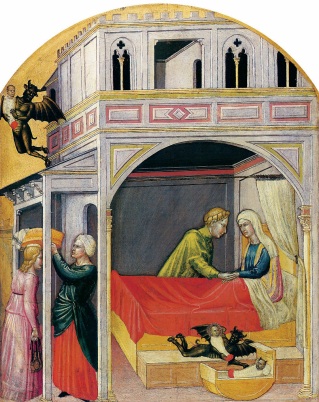 Here’s a saint many Christians are likely to recognize, recorded in the Book of Acts as having been stoned to death and becoming the first martyr of Christianity. But few are familiar with a pretty hilarious legend that arose probably near the end of the middle ages regarding his birth. The legend survives almost exclusively in an early 15th century altarpiece by Martino di Bartolomeo. The first panel seen here depicts Satan flying in and kidnapping St. Stephen, replacing him with a demonic changeling recognized only by its adorable red horns. Next we see Bishop Julian’s finding of the young Stephen, being nursed by a white deer (classic gag). This then leads to their discovery and burning of the changeling – who interestingly enough seems to have already become a grown child. The artwork itself really does this legend justice.
Here’s a saint many Christians are likely to recognize, recorded in the Book of Acts as having been stoned to death and becoming the first martyr of Christianity. But few are familiar with a pretty hilarious legend that arose probably near the end of the middle ages regarding his birth. The legend survives almost exclusively in an early 15th century altarpiece by Martino di Bartolomeo. The first panel seen here depicts Satan flying in and kidnapping St. Stephen, replacing him with a demonic changeling recognized only by its adorable red horns. Next we see Bishop Julian’s finding of the young Stephen, being nursed by a white deer (classic gag). This then leads to their discovery and burning of the changeling – who interestingly enough seems to have already become a grown child. The artwork itself really does this legend justice.
Click here to view each scene of the altarpiece.
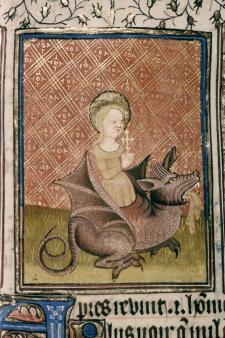 St. Margaret of Antioch (? — 304): Escaped being eaten by a dragon
St. Margaret of Antioch (? — 304): Escaped being eaten by a dragon
Born the daughter of a pagan priest and consecrating her virginity to Christ at a very young age, Margaret’s life reached a climax when she refused to marry the local prefect who then had her imprisoned and tortured. According to the version found in The Golden Legend, while in prison she was swallowed by Satan in the form of a dragon. She managed to escaped when the cross she was barring irritated the dragon’s innards. The large number of artistic pieces rendering this scene are quite entertaining.
Click here to view more artwork of St. Margaret
 St. Joseph of Cupertino (1603 – 1663): The Flying Friar
St. Joseph of Cupertino (1603 – 1663): The Flying Friar
Where Joseph lacked in smarts he made up for in levitation, a miraculous ability which has been attributed to other Saints as well. Born in a stable (sound familiar?) it is said that Joseph had ecstatic visions from childhood onward. Following his ordination as a priest in 1628, he was sent to the Shrine of the Madonna della Grazia where his divine experiences multiplied – climaxing with reports of his ability to levitate during Mass. Unfortunately for him, the inquisition equated flying/levitation with witchcraft. The church continually transferred Joseph to different friaries where he remained under tight supervision. It is interesting to note that his flying ability has marked him as the patron saint of aviation and astronauts, while his learning disability makes him the patron saint of mental handicaps, test taking, and students.
Click here to view more artwork of St. Joseph
 Blessed Agostino Novello (1240 – 1309): Your friendly neighborhood super-monk
Blessed Agostino Novello (1240 – 1309): Your friendly neighborhood super-monk
Though technically not a saint (fans from his monastery failed in their attempt to canonize him), it can be argued that Agostino Novello still qualifies for this list due to his remarkable saintly deeds and legends attributed to him. The best case for this is found in an altarpiece painted by my favorite medieval artist, Simone Martini. Here Agostino has the iconography of a saint, saving children in three of the four scenes: one from a wolf, one from falling out of a cradle, and one from falling off a balcony – swooping down just in time like a comic book superhero.
Click here to view each scene of the altarpiece
 St. Roch (c. 1328 – c. 1376): Saved from the plague by Lassie
St. Roch (c. 1328 – c. 1376): Saved from the plague by Lassie
Arriving in Italy during the plague epidemic, St. Roch (or Rocco) is said to have healed many with prayer and the sign of the cross. It was only a matter of time until he himself caught the plague and found himself wondering the forest on the verge of death – that is until a dog owned by a nearby noblemen appeared out of nowhere, supplying him with bread and licking the infection on his leg which miraculously healed it. It’s no wonder then that St. Roch is recognized as the patron saint of dogs, with his name invoked to combat knee problems and skin diseases. In artwork he is often seen lifting his tunic to expose his plague infected leg in hopes of hailing a cab receiving treatment from the dog next to him.
Click here to view more artwork of St. Roch
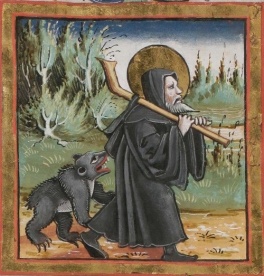 St. Gall (550 – 646): Acquired a pet bear
St. Gall (550 – 646): Acquired a pet bear
In addition to releasing a demon from a woman betrothed to the King of Franks, there exists a legend of St. Gall that would have made even the Grizzly Man jealous. One day, while resting by a campfire in the forests of what is now Switzerland, a bear emerged from the trees and charged at the saint. Unshaken, Gall stood up and rebuked the bear, causing it to retreat in awe of his presence. The bear subsequently returned with wood and rested by the fire with St. Gall, traveling with him as a close companion from that day onward. In another version, “Gall was accompanied by a deacon named Hiltibod. One night while Hiltibod was sleeping Gall arose and started praying at a cross he had set up and from which he had hung a satchel of relics. A bear came by, attracted by the remains of the two men’s supper. Gall said to the bear, ‘In the name of the Lord, I command you to take up a log and throw it on the fire.’ When the bear obliged, Gall gave him a loaf of bread, saying, ‘In the name of my Lord Jesus Christ, depart from this valley; you are free to range the hills and mountains around at will so long as you do no harm to man or beast in this spot.'” [5] Interesting enough, legend has it that St. Jerome also acquired a beastly pet.
Click here to view more artwork of St. Gall
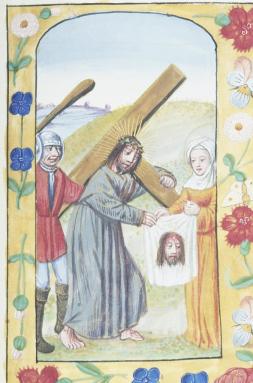 St. Veronica (1st century AD): Obtained Jesus’ face on a cloth (Veil of Veronica)
St. Veronica (1st century AD): Obtained Jesus’ face on a cloth (Veil of Veronica)
Our final saint is arguably the most famous on our list, even making the cut in Mel Gibson’s The Passion of the Christ under the name “Seraphia”. According to Roman Catholic tradition, Veronica was spectating on the sidelines as Jesus carried his cross to Golgotha when she handed him her veil to wipe his face with. Jesus, being the jokester he is, handed the cloth back with his face literally wiped off onto it. Later, she used it to heal Emperor Tiberius. The gospels themselves never allude to this incident, though a close resemblance is the woman who was healed by touching Jesus’ garment in Luke 8:43–48 – who is later named Veronica in the apocryphal Acts of Pilate. It is only during the eleventh century that Jesus was said to have given her a portrait of herself on a piece of cloth, and around 1380 when her embellishment into the passion narrative appears. Today there exist a number of churches claiming to own the Christian relic known as the Veil of Veronica – all of which look extremely convincing.
Click here to view more artwork of St. Veronica and her veil
Bonus: Startling Iconography of Martyred Saints
St. Denis of Paris (3rd century AD — c. 250): Carried his own head
In the third century, he was Bishop of Paris. He was martyred in connection with the Decian persecution of Christians, shortly after 250 AD. Denis is said to have picked his head up after being decapitated, walked ten kilometres (six miles), and preached a sermon the entire way, making him one of many cephalophores in hagiology. Of the many accounts of this martyrdom, this is noted in detail in the Golden Legend and in Butler’s Lives Of The Saints. The site where he stopped preaching and actually died was marked by a small shrine that developed into the Saint Denis Basilica, which became the burial place for the kings of France. Another account has his corpse being thrown into the Seine, but recovered and buried later that night by his converts.
Click here to view more artwork of St. Denis
St. John the Apostle (c. 6 — c. 100): Boiled alive in a vat of oil
[Legend of John the Apostle was] active in the West, being especially stimulated by the passage in Mark 10:39, with its hints of John’s martyrdom. Tertullian, the 2nd-century North African theologian, reports that John was plunged into boiling oil from which he miraculously escaped unscathed. During the 7th century this scene was portrayed in the Lateran basilica and located in Rome by the Latin Gate; it is still annually commemorated on May 6. John’s feast day otherwise is December 27. This belief that John did not die is based on an early tradition. In the original form of the apocryphal Acts of John (second half of the 2nd century) the apostle dies, but in later traditions he is assumed to have ascended to heaven like Enoch and Elijah. A popular tradition known to Augustine declared that the earth over his grave heaved as if the apostle were still breathing.
Is it just me or does it look like John’s receiving spa treatment complete with an angelic massage?
Click here to view more artwork of St. John
Saint Erasmus of Formia (3rd century AD — c. 303): Disemboweled
[Also known as St. Elmo,] Erasmus was an early Christian bishop, martyr, and one of the patron saints of sailors, who is romantically associated with Saint Elmo’s fire (the glow accompanying the brushlike discharges of atmospheric electricity that appears as a tip of light on the masts of ships during stormy weather) as the visible sign of his guardianship over them. Erasmus is one of the Fourteen Holy Helpers, a group of saints conjointly venerated in medieval Germany.
He is reported to have been bishop of Formia, where he was martyred, probably during the persecution of Christians by the Roman emperor Diocletian. According to Pope Gregory I (reigned 590–604), his relics were kept in the Cathedral of Formia. After the Saracens destroyed Formia in 842, Erasmus’ body was transferred to Gaeta, Italy, where he is honoured as patron saint.
Several spurious acta have embellished his legend. According to these, he was a bishop in Syria who miraculously endured tortures under Diocletian in Lebanon, after which he was guided by an angel to Formia, where he performed many miracles. He has been confused with the Syrian St. Erasmus of Antioch; some scholars propose that they are the same person. Later legends attest that he was martyred by being disemboweled; thus, as a Holy Helper, he was invoked by those suffering from intestinal maladies. Elmo is an Italian corruption (through Sant’ Ermo) of St. Erasmus; other derivations include Ramus, Eramus, Ermus, Ermo, and Telmo. His legendary narrative is in Acta Sanctorum.
Click here to view more artwork of St. Erasmus
St. Hippolytus of Rome (170 — 235): Pulled apart by horses
As punishment [for preserving St. Lawrence’s body, Hippolytus] was tortured and then killed by having his legs tied to wild horses. The first part of this story is usually told as part of Lawrence’s passion, and the second as a separate passion under Hippolytus’ own name.
The legends are ambiguous about precisely how the saint died. In many, the horses drag him over the countryside so that his flesh is torn by thistles and stones. But as early as the Old GothicMissal (late 7th or early 8th century) it is asserted both that his flesh was torn and that the horses pulled him apart (Acta Sanctorum, August vol. 3, 6). This is hard to visualize. To drag the man, they would have to be going in the same direction; to pull him apart, they would have to be going in different directions.
Artists seem to prefer the second alternative. A manuscript illumination from the 14th century has two horses pulling the saint in opposite directions. The Golden Legend also specifies two horses, as does the South English Legendary. The number grows to four in Derek Bouts’s 15th-century painting, where the horses are pulling Hippolytus’ body apart, not dragging him anywhere.
Click here to view more artwork of St. Hippolytus
St. Ignatius of Antioch (c. 35 — c. 107): Eaten by Lions
Ignatius is one of the five Apostolic Fathers (the earliest authoritative group of the Church Fathers). He based his authority on being a bishop of the Church, living his life in the imitation of Christ. It is believed that St. Ignatius, along with his friend Polycarp, with great probability were disciples of the Apostle St. John.
Epistles attributed to Ignatius report his arrest by the authorities and travel to Rome:
“From Syria even to Rome I fight with wild beasts, by land and sea, by night and by day, being bound amidst ten leopards, even a company of soldiers, who only grow worse when they are kindly treated.” — Ignatius to the Romans, 5.
Along the route he wrote six letters to the churches in the region and one to a fellow bishop. According to Christian legend, he was sentenced to die at the Colosseum. In his Chronicle, Eusebius gives the date of Ignatius’s death as AA 2124 (2124 years after Adam), which would amount to the 11th year of Trajan’s reign; i.e., AD 108.
According to Christian legend, after Ignatius’ martyrdom in the Colosseum his remains were carried back to Antioch by his companions and were interred outside the city gates. The reputed remains of Ignatius were moved by the Emperor Theodosius II to the Tychaeum, or Temple of Tyche, which had been converted into a church dedicated to Ignatius. In 637 the relics were transferred to the Basilica di San Clemente in Rome.
Click here to view more artwork of St. Ignatius
St. Lucy (c. 283 – c. 304): Had her eyes removed
Absent in the early narratives and traditions, at least until the 15th century, is the story of Lucia tortured by eye-gouging. According to later accounts, before she died she foretold the punishment of Paschasius and the speedy end of the persecution, adding that Diocletian would reign no more, and Maximian would meet his end. This so angered Paschasius that he ordered the guards to remove her eyes. Another version has Lucy taking her own eyes out in order to discourage a persistent suitor who admired them. When her body was prepared for burial in the family mausoleum it was discovered that her eyes had been miraculously restored.
In paintings St. Lucy is frequently shown holding her eyes on a golden plate. Lucy was represented in Gothic art holding a dish with two eyes on it. She also holds the palm branch, symbol of victory over evil.
Click here to view more artwork of St. Lucy
St. Agatha (c. 231 — c. 251): Had her breasts removed
Having dedicated her virginity to God, fifteen year old Agatha, from a rich and noble family, rejected the amorous advances of the low-born Roman prefect Quintianus, who then persecuted her for her Christian faith. He sent Agatha to Aphrodisia, the keeper of a brothel.
The madam finding her intractable, Quinitianus sends for her, argues, threatens, and finally has her put in prison. Among the tortures she underwent was the cutting off of her breasts. After further dramatic confrontations with Quintianus, represented in a sequence of dialogues in her passio that document her fortitude and steadfast devotion. Saint Agatha was then sentenced to be burned at the stake, but an earthquake saved her from that fate; instead, she was sent to prison where St. Peter the Apostle appeared to her and healed her wounds. Saint Agatha died in prison, according to the Legenda Aurea in “the year of our Lord two hundred and fifty-three in the time of Decius, the emperor of Rome.”
Saint Agatha is often depicted iconographically carrying her excised breasts on a platter, as by Bernardino Luini’s Saint Agatha (1510–15) in the Galleria Borghese, Rome, in which Agatha contemplates the breasts on a standing salver held in her hand. She is the patron saint of breast cancer patients, martyrs, wet nurses, bell-founders, bakers, fire, earthquakes, and eruptions of Mount Etna.
Click here to view more artwork of St. Agatha
St. Apollonia (? — 249 AD): Had her teeth removed
Saint Apollonia was one of a group of virgin martyrs who suffered in Alexandria during a local uprising against the Christians prior to the persecution of Decius. According to legend, her torture included having all of her teeth violently pulled out or shattered. For this reason, she is popularly regarded as the patroness of dentistry and those suffering from toothache or other dental problems.
In the Middle Ages, objects claimed to be her teeth were sold as toothache cures. During the reign of Henry VI of England, several tons of these purported teeth were collected in an effort to stop the scam.
Click here to view more artwork of St. Apollonia
St. Bartholomew the Apostle (1st century AD — 1st century AD)
Christian tradition has three stories about Bartholomew’s death: One speaks of his being kidnapped, beaten unconscious, and cast into the sea to drown. Another account states that he was crucified upside down, and another says that he was skinned alive and beheaded in Albac or Albanopolis, near Başkale, Turkey.
The account of Bartholomew being skinned alive is the most represented in works of art, and consequently Bartholomew is often shown with a large knife, holding his own skin (as in Michelangelo’s Last Judgment), or both. Bartholomew is also the patron saint of tanners.
Click here to view more artwork of St. Bartholomew
St. Agnes of Rome (c. 291 — 304): Sent to a brothel then condemned to be burned
Saint Agnes was a member of the Roman nobility born c. 291 and raised in a Christian family. She suffered martyrdom at the age of 12 during the reign of the Eastern Roman Emperor Diocletian, on January 21, 304. Agnes’ parents were pagans, but she had learned about Jesus and the Gospel from her nurse-slave, with whom she was very close. Phocus, the son of the prefect Roman governor Sempronius, was one of several rich young men who fell in love with Agnes. He brought her rich gifts of jewels, but she rejected his courtship, saying, “I am already the spouse of a Lover much more noble and powerful than you.”
The dejected Phocus later learned that Agnes was a Christian and denounced her to his father. Sempronius questioned her officially, and she freely admitted her faith in Jesus. He ordered her to go the temple of Vesta—the virgin goddess of the hearth, home, and family—to offer her a sacrifice, or even to devote herself as one of the Vestal Virgins, but Agnes steadfastly refused any compromise with pagan practice.
Threats of death also did not sway her (some sources indicate that Roman law did not permit the execution of virgins), so the judge threatened her chastity instead. Even this did not frighten her into submission, and Agnes was thus stripped naked and dragged through the streets to a brothel. On the way, as the saint prayed, her hair miraculously grew and covered her body to protect her modesty. At the brothel, she was protected by an angel when several men attempted to have their way with her by force (some versions name Phocus as her attacker). All of those who attempted to rape her were immediately struck blind and/or paralyzed.Although Agnes remained a virgin, she was now condemned as a witch and led out tied to a stake to be burned. However, the bundle of wood would not burn, whereupon the officer in charge drew his sword and struck off her head (or stabbed her in the throat). The execution reportedly shocked even the bloodthirsty pagan crowd, since Agnes was so young and pure. Thus, her death created a new wave of sympathy for the Christians and brought many to the faith.
Click here to view more artwork of St. Agnes
Sources and Further Reading
- The Oxford Dictionary of Saints
- The Illustrated World Encyclopedia of Saints
- Wikipedia List of Saints
- The Golden Legend: Readings on the Saints by Jacobus de Voragine
- Christian Iconography
[1] “What is a Saint?” Further information about the history of the title.
[2] Life of Saint Catharine of Sienna by Ramond of Capua
[3] The Lactation Miracle of St. Bernard article via dspt.edu
[4] Jesus as Mother: Studies in the Spirituality of the High Middle Ages by Caroline Walker Bynum, p. 132-133

Good list even though it misses one of my favourites – St Fabiola as described in the Penguin Dictionary of Saints
What unusual thing does it say about her?